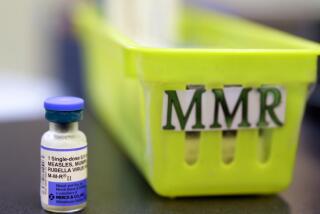Losing Ground on Vaccines
- Share via
Vaccines protect children from illness and death caused by common childhood diseases. The goal, then, should be to increase vaccination rates among children, but instead those rates are decreasing because of the rising cost of vaccines and the cutbacks in federal spending. A new report from the Children’s Defense Fund says that, as a result, the number of reported cases of measles, mumps and whooping cough is rising. In this area more than 35 cases of measles have been reported since late November at South High School in Torrance.
The United States slacks off even as UNICEF and Third World nations conduct a global campaign to immunize children against preventable diseases. But, as the children’s fund notes, the battle is not over even in this country. “The potential for infection still exists in every (American) community,” where for years children have been safe from serious harm from controllable diseases.
According to the fund:
--Between 1980 and 1985 the proportion of 1- to 4-year olds who got no polio vaccine rose by 40% for children of all races and 80% for non-white children.
--For children under the age of 2, immunization rates fell in those years for seven diseases: polio, measles, rubella, mumps, diphtheria, tetanus and pertussis, or whooping cough.
--Reported cases of measles have risen dramatically since 1983. After declining for 15 years, the number of cases of mumps rose in 1986.
One problem is that the cost of measles, mumps and rubella vaccines have doubled--in constant dollars--since 1979, driven up by manufacturers’ concerns over liability and the short shelf life of vaccines. Another problem is that federal spending for vaccines hasn’t kept pace with rising costs. In 1979 federal grants to states bought 17.4 million doses of vaccine. In fiscal 1986 the grants bought only 16.2 million doses.
The Census Bureau no longer conducts an immunization survey for the Centers for Disease Control, which leaves the government without information to alert it to potential public-health trouble spots.
In its new budget Congress agreed to spend $5 million to build an adequate stockpile of vaccines--a vital need. It increased appropriations for immunization, but not to the full $94 million that it promised earlier.
A population cannot be considered well protected against the spread of preventable diseases until 80% to 90% of the people have been vaccinated. Nearly a decade ago the U.S. surgeon general set 1990 as the year by which that degree of protection should be achieved. Unless Congress and the Administration act swiftly, even that modest goal won’t be met.
More to Read
Sign up for Essential California
The most important California stories and recommendations in your inbox every morning.
You may occasionally receive promotional content from the Los Angeles Times.










